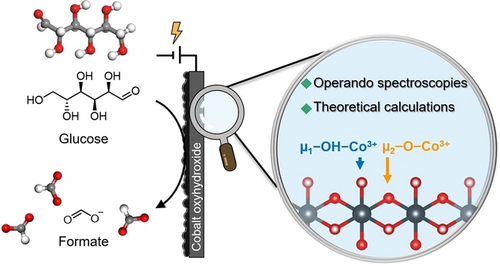Transition metal (oxy)hydroxides are well-known catalysts for biomass electrooxidation to produce valuable chemicals. However, identification of active site remains elusive, owing to the structural complexity under reaction conditions. To tackle this issue, Hua Zhou, Haohong Duan et al. investigated the dynamic transformation of the electronic and atomic structure of cobalt oxyhydroxide (CoOOH) in the electrocatalytic glucose oxidation reaction (GOR) using a suite of operando and ex situ techniques. They revealed that two types of reducible Co3+-oxo species are afforded for the GOR, including adsorbed hydroxyl on Co3+ ion (μ1-OH−Co3+) and di-Co3+-bridged lattice oxygen (μ2-O−Co3+). Moreover, theoretical calculations unveil that μ1-OH−Co3+ is responsible for oxygenation, while μ2-O−Co3+ mainly contributes to dehydrogenation, both as key oxidative steps in glucose-to-formate transformation. This work provides a framework for mechanistic understanding of the complex near-surface chemistry of metal oxyhydroxides in biomass electrorefining. (Angew. Chem. Int. Ed. 62, e202219048 (2023))

Title: Scalable electrosynthesis of commodity chemicals from biomass by suppressing non-Faradaic transformations
Authors: Hua Zhou#, Yue Ren#, Bingxin Yao, Zhenhua Li, Xianggui Kong, Lirong Zheng, Mingfei Shao, MingXu, LinaMa, Haohong Duan*
Electrooxidation of biomass platforms provides a sustainable route to produce valuable oxygenates, but the practical implementation is hampered by the severe carbon loss stemming from inherent instability of substrates and/or intermediates in alkaline electrolyte, especially under high concentration. To tackle this issue, Hua Zhou, Haohong Duan et al. developed a single-pass continuous flow reactor (SPCFR) system with high ratio of electrode-area/electrolyte-volume, short duration time of substrates in the reactor, and separate feeding of substrate and alkaline solution, thus largely suppressing non-Faradaic degradation. By constructing a nine-stacked modules SPCFR system, they achieved electrooxidation of glucose-to-formate and 5-hydroxymethylfurfural (HMF)-to-2,5-furandicarboxylic acid (FDCA) with high single-pass conversion efficiency (SPCE; 81.8% and 95.8%, respectively) and high selectivity (formate: 76.5%, FDCA: 96.9%) at high concentrations (formate: 562.8 mM, FDCA: 556.9 mM). Furthermore, they demonstrated continuous and kilogram-scale electrosynthesis of potassium diformate (0.7 kg) from wood and soybean oil, and FDCA (1.17 kg) from HMF. This work highlights the importance of understanding and suppressing non-Faradaic degradation, providing opportunities for scalable biomass upgrading using electrochemical technology. (Nat. Commun. 14, 5621 (2023))

